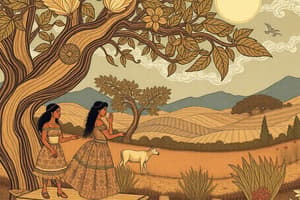Podcast
Questions and Answers
What was a significant impact of the pastoral expansion in Australia on Aboriginal Australians?
What was a significant impact of the pastoral expansion in Australia on Aboriginal Australians?
- Forced displacement onto reserves (correct)
- Increased land ownership for indigenous tribes
- Enhanced preservation of traditional ways of life
- Encouraged cultural exchange
Which activity contributed to the decline in indigenous culture and lifestyles in Brazil during the late 19th century?
Which activity contributed to the decline in indigenous culture and lifestyles in Brazil during the late 19th century?
- Rubber tappers moving back to rainforests
- Investment in indigenous education
- Large-scale agricultural projects like cattle ranching (correct)
- Promotion of indigenous cultural festivals
What was the outcome of the rubber boom in Brazil on the local population's livelihoods?
What was the outcome of the rubber boom in Brazil on the local population's livelihoods?
- Improvement in economic opportunities
- Increased access to healthcare
- Diversification of livelihood options
- Severe impact on livelihoods (correct)
By the end of the 19th century, how much of Australia remained in Aboriginal hands?
By the end of the 19th century, how much of Australia remained in Aboriginal hands?
Despite international agreements like the UN Declaration on the Rights of Indigenous Peoples, what still persists according to the text?
Despite international agreements like the UN Declaration on the Rights of Indigenous Peoples, what still persists according to the text?
What has been a common driver behind the displacement of indigenous peoples globally according to the text?
What has been a common driver behind the displacement of indigenous peoples globally according to the text?
During the Trail of Tears, which tribes were primarily affected by forced relocation?
During the Trail of Tears, which tribes were primarily affected by forced relocation?
What was one of the primary reasons for the displacement of indigenous peoples in North America?
What was one of the primary reasons for the displacement of indigenous peoples in North America?
What harsh process did the indigenous people subjected to during the Trail of Tears?
What harsh process did the indigenous people subjected to during the Trail of Tears?
What triggered the forced displacement of native Californians from their lands in 1849?
What triggered the forced displacement of native Californians from their lands in 1849?
Why were indigenous Californians forced off their ancestral lands during the gold rush?
Why were indigenous Californians forced off their ancestral lands during the gold rush?
Which term best describes the historical injustices faced by indigenous populations due to policies favoring economic progress over cultural preservation?
Which term best describes the historical injustices faced by indigenous populations due to policies favoring economic progress over cultural preservation?
Study Notes
Displacing Indigenous Peoples: Historical Injustices
The displacement of indigenous peoples has been a persistent issue throughout history, often resulting from colonialism, land appropriation, and policies that favor economic progress over cultural preservation. This phenomenon is particularly evident when examining the histories of various regions around the world, where indigenous people have faced forced removal from their lands and communities due to external pressures. Here, we explore some key examples of these historical injustices against indigenous populations.
North America
In North America, one of the most infamous cases of the displacement of native tribes was the Trail of Tears in the United States. Between 1830 and 1850, the U.S. government forcefully relocated thousands of Native Americans, primarily Cherokee, Choctaw, Creek, Seminole, and Chickasaw nations, from the southeastern states to reservations in the western territories of Oklahoma. This process involved walking hundreds of miles under harsh conditions, with many deaths occurring during the journey itself.
Another significant instance occurred after the discovery of gold in California in 1849. As mining operations expanded rapidly, native Californians were forced off their ancestral lands by both white settlers and other ethnic groups who moved into the area seeking opportunities created by the gold rush.
Australia
A similar pattern unfolded in Australia with the pastoral expansion of European colonists. Aboriginal Australians experienced the loss of vast tracts of land as they were forced onto reserves, which led to the fragmentation of tribes and disruption of traditional ways of life. By the end of the 19th century, only about a quarter of the continent remained in Aboriginal hands; the rest had been taken over by British colonizers, leading to the widespread destruction of indigenous societies.
Brazil
In Brazil, the rubber boom of the late 19th century brought about significant changes in the Amazon region. Rubber tappers, mostly indigenous people, were moved out of the rainforest to make way for large-scale agricultural projects such as cattle ranching, soybean production, and sugar cane cultivation. These developments severely impacted the local population's livelihoods and resulted in a decline in indigenous culture and lifestyles.
A Global Issue
These instances exemplify how displacement of indigenous peoples has been a global problem across continents and centuries. Often driven by economic interests, it has resulted in the destruction of cultures, traditions, and environments that have sustained these populations for millennia. Despite international recognition of indigenous rights through agreements like the UN Declaration on the Rights of Indigenous Peoples, these injustices continue to persist, highlighting the ongoing need for vigilance and action towards rectifying this historical wrong.
Studying That Suits You
Use AI to generate personalized quizzes and flashcards to suit your learning preferences.
Description
Explore the historical injustices faced by indigenous populations due to colonialism, land appropriation, and policies favoring economic progress over cultural preservation. Learn about key examples of displacement such as the Trail of Tears in North America, pastoral expansion in Australia, and the impact of the rubber boom in Brazil.




